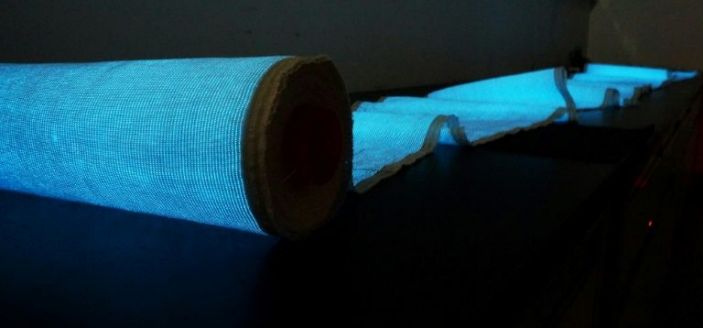At first glance, the fabric looks like a pretty if not especially original scarf, with turquoise, blue and orange stripes in an open weave. But this fabric can communicate.
It’s wearable, foldable and washable, but it’s also a fully functioning display—capable of flashing messages or images, or even being used with a keyboard.
The fabric, described in a study in the journal Nature on Wednesday, is the work of a team led by Huisheng Peng, a professor in the department of macromolecular engineering at Shanghai’s Fudan University.
He believes it could revolutionize communication and “help individuals with voice, speech or language difficulties to express themselves to others”.
“We hope that woven-fiber materials will shape next-generation electronics by changing the way we interact with electronic devices,” he told AFP.
Wearable electronics have advanced significantly in recent years, and clothing incorporating electronic functions including super-thin displays is already available.
Another study published this week, for example, describes a wearable microgrid powered by the sweat of the wearer.
But there are limitations to most existing products.
They are often made by attaching or weaving thin film light-emitting devices to fabrics, resulting in a material that is not breathable or very flexible.
They are also often fragile and prone to damage, and in the past were only able to display pre-determined patterns.
Warp and weft
Peng and his colleagues have spent a decade thinking about ways to improve existing technology, experimenting with different materials.
One option they formulated did not display well in the dark, while another fiber they came up with did not perform when it was woven.
The breakthrough came after examining the structure of textiles and the way threads intersect with each other in the warp and weft of a woven piece.
The team decided to try to create minuscule points of light where the fibers of a woven cloth meet.
To make these tiny dots of light, they needed a luminescent warp and a conductive weft that could be woven together with cotton or similar fibers.
After testing different combinations, they settled on a silver-plated yarn warp coated with luminescent composite, and a conductive weft spun from a kind of gel.
The two materials were woven with cotton into a piece of fabric six meters long and 25 centimeters wide.
Applying an electrical current caused the layer on the silver-plated yarn to light up where it was in contact with the conductive gel fiber.
The amount of power needed to light up the display material was limited, producing no significant heating, the authors say, and the fabric survived a number of stress tests.
It was left in the open air for a month, put through 100 wash-and-dry cycles and folded 10,000 times, all without losing brightness.

Overcoming language barriers
The study says the fabric can be powered with batteries or even use solar energy.
But what purpose might it serve?
Peng sees a variety of options, including a dynamic sleeve display that could, for example, allow a driver to view a GPS map on their arm as they move around.
But he is hopeful the material could also help people overcome difficulty communicating because of health problems or language barriers.
In one experiment with the fabric, they collected brainwaves from volunteers who had either been playing a race car game or meditating—simulating a person in a stressed or relaxed state.
When paired with a processor, the waves could then be translated into messages displayed on the fabric reading either “relaxed” or “anxious”.
Peng said there were several improvements to the fabric the team would now work on, including making the display brighter, the resolution clearer, and the luminescent points available in more colours.
Scientists awarded a Guinness World Record for the finest woven fabric
More information:
Large-area display textiles integrated with functional systems, Nature (2021). DOI: 10.1038/s41586-021-03295-8 , dx.doi.org/10.1038/s41586-021-03295-8
2021 AFP
Citation:
A scarf that speaks? Scientists develop message display fabric (2021, March 10)
retrieved 10 March 2021
from https://techxplore.com/news/2021-03-scarf-scientists-message-fabric.html
This document is subject to copyright. Apart from any fair dealing for the purpose of private study or research, no
part may be reproduced without the written permission. The content is provided for information purposes only.



